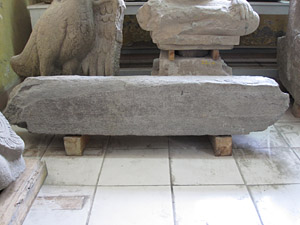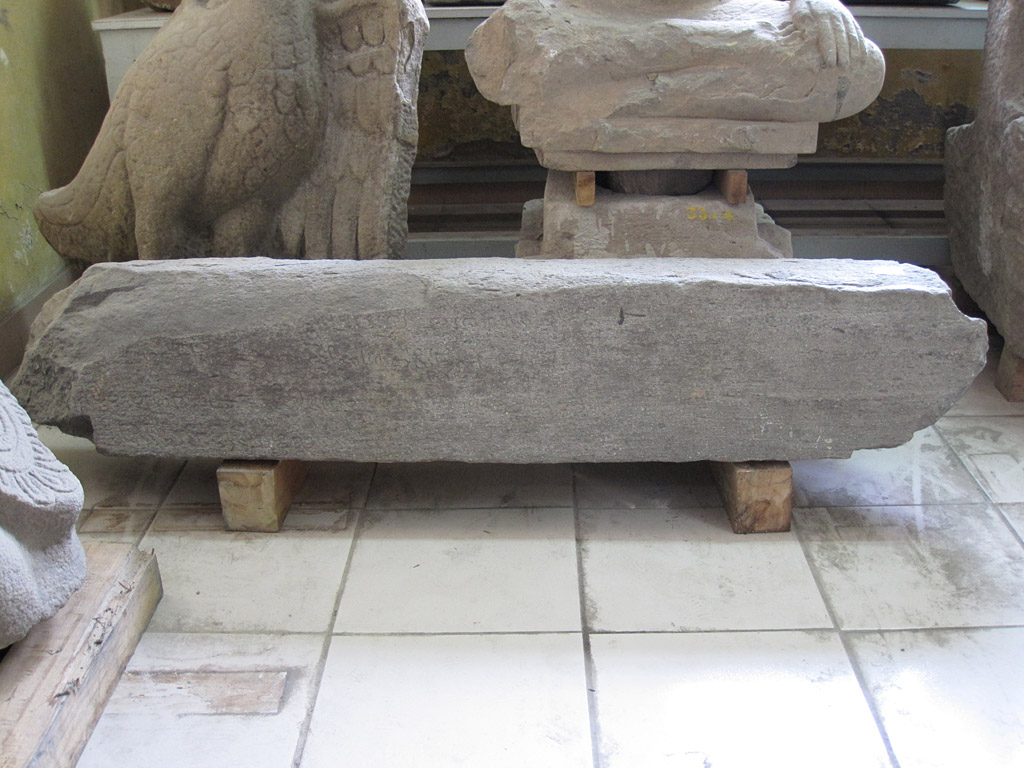Corpus of the Inscriptions of Campā




C. 150 Stone beam of Rồn in Quảng Bình
Please note: you are reviewing a preprint version of this publication. Contents here may change significantly in future versions. Scholars with specific interests are urged to consult all cited bibliography before using our texts and translations or drawing other significant conclusions.
Support Roughly prepared beam or frieze; granite (?); h. 32 cm × w. 148 × d. 38.
Text Four lines on one face written in Sanskrit.
Date possibly the early 9th century CE.1
Origin River of Cửa Rồn (Bac Hạ, Quảng Trạch, Quảng Bình, Vietnam).Settlement of Bac Hạ (Quảng Trạch, Quảng Bình, Vietnam).
The beam or frieze was discovered by Charles-B. Maybon, as reported in JA 1908/2, p. 31; it was inventoried and its findspot described by Parmentier 1909: 550. The inscription was moved to the Tourane Museum at some point between the publication of Parmentier 1919 (where it is not mentioned) and 1923, when its inventory number 1,6 there was published in IC. We identified the inscription at the same museum, now called Bảo tàng Điêu khắc Chăm Đà Nẵng (Museum of Cham Sculpture at Đà Nẵng) in 2010 (ECIC III: 449).
Edition(s) First published, with French translation, in Huber 1911: 267; whence, with English translation, in Majumdar 1927: 225-226, whence Golzio 2004: 77. Newly edited in Đà Nẵng Catalog: 235-236, whence the present edition.
Facsimiles
- Estampage: EFEO 843
- Estampage: EFEO n. 2070
The following text was edited by Arlo Griffiths.
(2) kos·ruluṅ·kṣetraṁ etat sarvvaṁ draṁvihāradravyaṁ dvīśatamāṇaṁ pañcāśadadhika[ṁ] śrī{ ? }
(3) rājena pitṛsadbhaktimatā dattam iti || ye rakṣanti ca tad { ? } [ga-]
(4) cchantu surālayam· ye nāśayan[t]i { ? }
1 om̐ ◇ namaḥ Huber. — bhagavate ◇ bhāgavate Huber. — ḍamareśvarāya ◇ ḍāmareśvarāya Huber. — vāṅkṣetraṁ dv[i] ◇ pãrkṣetraṁ tradvaḥ Huber. There definitely is no repetition of the syllable tra at the end of the line, as Huber seems to have supposed. — 2 kos·ruluṅ·kṣetraṁ ◇ ... kṣetram Huber. Huber reads only the last element, and inaccurately represents the anusvāra. — draṁ ◇ vraḥ Huber. — dvīśatamāṇaṁ ◇ Huber's note “Corr. mānam” in line 1 was probably inserted in the wrong place by the typesetter, and should be attributed to this word. — 3 rājena pitṛsadbhaktimatā ◇ rājena ... bhaktimatā Huber. — 3-4 rakṣanti ca tad{ ? }[ga]cchantu surālayam· ye ◇ rakṣanti ... ye Huber.
Translations
English
Om. 'To the lord Śrī Ḍamareśvara was given, by the king ..., who was full of pure devotion for his parents: the field Tilvit, the field Vāṅ ..., the field Kos Ruluṅ, all that property of the Dram monastery, two hundred plus fifty.' [Therefore]: 'They who protect that ... will go to heaven. They who destroy ...'.
French
TO BE SUPPLIED
Commentary
Secondary Bibliography
- Chutiwongs 2002: 295.
Notes
- The inscription is undated, and the claim of Boisselier 1963: 118 that it dates to 889 CE must be based on some kind of confusion. Its script resembles that of the inscriptions issued by a king Vikrāntavarman in Southern Campā, which date between the first quarter and the middle of the 9th century. Some aspects of the contents too seem to agree with the inscriptions issued under this king Vikrāntavarman in Pāṇḍuraṅga and Kuṭhāra, e.g. the problematic word draṁ, which is found in equally problematic context in the inscription added by Vikrāntavarman on the base of the stela from the temple of Po Nagar at Nha Trang (C. 38).



The text records a donation of land in favor of the otherwise unknown figure Ḍamareśvara. The name, meaning 'Lord of Riots', would at first sight seem to evoke Śiva. According to Huber, who cites no source, this is a name of Avalokiteśvara, but we know no evidence to support this identification. We tentatively assume the name is a Sanskritisation of a Cam name, and that we see the same again, in slightly different guise, in the name draṁvihāra, which may mean 'Monastery of Dram'. Huber presumably thought of a Buddhist cult figure because the text mentions the word vihāra, which can indeed denote a Buddhist monastery, but can denote a Śaiva one as well: cf. C. 211.